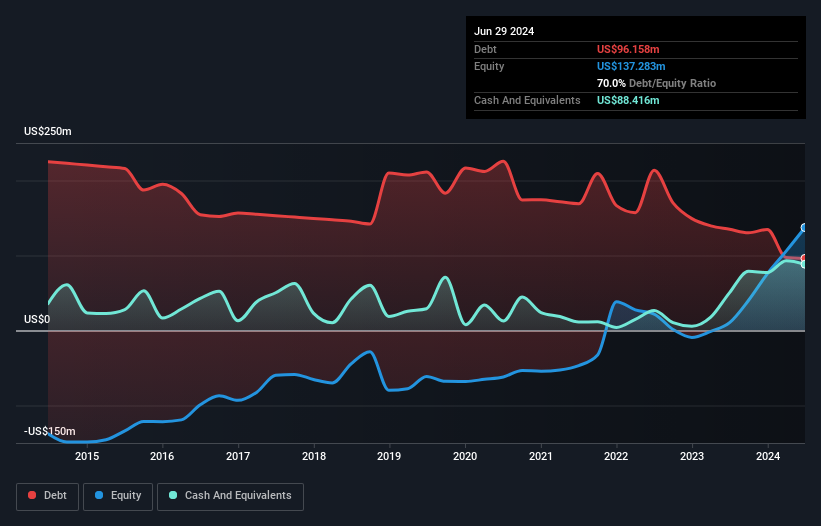The external fund manager backed by Berkshire Hathaway's Charlie Munger, Li Lu, makes no bones about it when he says 'The biggest investment risk is not the volatility of prices, but whether you will suffer a permanent loss of capital.' So it might be obvious that you need to consider debt, when you think about how risky any given stock is, because too much debt can sink a company. Importantly, Blue Bird Corporation (NASDAQ:BLBD) does carry debt. But should shareholders be worried about its use of debt?
What Risk Does Debt Bring?
Debt and other liabilities become risky for a business when it cannot easily fulfill those obligations, either with free cash flow or by raising capital at an attractive price. In the worst case scenario, a company can go bankrupt if it cannot pay its creditors. However, a more usual (but still expensive) situation is where a company must dilute shareholders at a cheap share price simply to get debt under control. By replacing dilution, though, debt can be an extremely good tool for businesses that need capital to invest in growth at high rates of return. When we examine debt levels, we first consider both cash and debt levels, together.
What Is Blue Bird's Net Debt?
The image below, which you can click on for greater detail, shows that Blue Bird had debt of US$96.2m at the end of June 2024, a reduction from US$134.9m over a year. However, because it has a cash reserve of US$88.4m, its net debt is less, at about US$7.74m.

A Look At Blue Bird's Liabilities
 Zooming in on the latest balance sheet data, we can see that Blue Bird had liabilities of US$197.6m due within 12 months and liabilities of US$133.2m due beyond that. Offsetting these obligations, it had cash of US$88.4m as well as receivables valued at US$34.0m due within 12 months. So it has liabilities totalling US$208.4m more than its cash and near-term receivables, combined.
Zooming in on the latest balance sheet data, we can see that Blue Bird had liabilities of US$197.6m due within 12 months and liabilities of US$133.2m due beyond that. Offsetting these obligations, it had cash of US$88.4m as well as receivables valued at US$34.0m due within 12 months. So it has liabilities totalling US$208.4m more than its cash and near-term receivables, combined.
Of course, Blue Bird has a market capitalization of US$1.18b, so these liabilities are probably manageable. However, we do think it is worth keeping an eye on its balance sheet strength, as it may change over time. Carrying virtually no net debt, Blue Bird has a very light debt load indeed.
In order to size up a company's debt relative to its earnings, we calculate its net debt divided by its earnings before interest, tax, depreciation, and amortization (EBITDA) and its earnings before interest and tax (EBIT) divided by its interest expense (its interest cover). This way, we consider both the absolute quantum of the debt, as well as the interest rates paid on it.
Blue Bird has very little debt (net of cash), and boasts a debt to EBITDA ratio of 0.05 and EBIT of 16.2 times the interest expense. So relative to past earnings, the debt load seems trivial. It was also good to see that despite losing money on the EBIT line last year, Blue Bird turned things around in the last 12 months, delivering and EBIT of US$143m. The balance sheet is clearly the area to focus on when you are analysing debt. But it is future earnings, more than anything, that will determine Blue Bird's ability to maintain a healthy balance sheet going forward. So if you're focused on the future you can check out this free report showing analyst profit forecasts.
But our final consideration is also important, because a company cannot pay debt with paper profits; it needs cold hard cash. So it's worth checking how much of the earnings before interest and tax (EBIT) is backed by free cash flow. Over the most recent year, Blue Bird recorded free cash flow worth 56% of its EBIT, which is around normal, given free cash flow excludes interest and tax. This cold hard cash means it can reduce its debt when it wants to.
Our View
The good news is that Blue Bird's demonstrated ability to cover its interest expense with its EBIT delights us like a fluffy puppy does a toddler. And the good news does not stop there, as its net debt to EBITDA also supports that impression! Taking all this data into account, it seems to us that Blue Bird takes a pretty sensible approach to debt. While that brings some risk, it can also enhance returns for shareholders. When analysing debt levels, the balance sheet is the obvious place to start. However, not all investment risk resides within the balance sheet - far from it. We've identified 1 warning sign with Blue Bird , and understanding them should be part of your investment process.
If you're interested in investing in businesses that can grow profits without the burden of debt, then check out this free list of growing businesses that have net cash on the balance sheet.
Have feedback on this article? Concerned about the content? Get in touch with us directly. Alternatively, email editorial-team (at) simplywallst.com.
This article by Simply Wall St is general in nature. We provide commentary based on historical data and analyst forecasts only using an unbiased methodology and our articles are not intended to be financial advice. It does not constitute a recommendation to buy or sell any stock, and does not take account of your objectives, or your financial situation. We aim to bring you long-term focused analysis driven by fundamental data. Note that our analysis may not factor in the latest price-sensitive company announcements or qualitative material. Simply Wall St has no position in any stocks mentioned.
